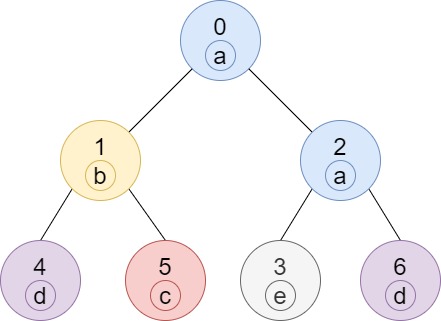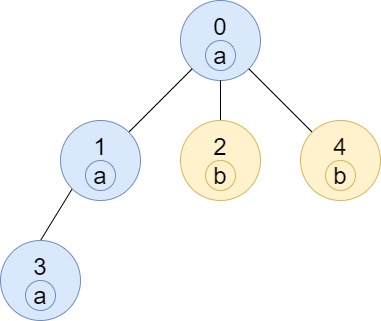Problem
You are given a tree (i.e. a connected, undirected graph that has no cycles) consisting of n nodes numbered from 0 to n - 1 and exactly n - 1 edges. The root of the tree is the node 0, and each node of the tree has a label which is a lower-case character given in the string labels (i.e. The node with the number i has the label labels[i]).
The edges array is given on the form edges[i] = [ai, bi], which means there is an edge between nodes ai and bi in the tree.
Return an array of size n where ans[i] is the number of nodes in the subtree of the ith node which have the same label as node i.
A subtree of a tree T is the tree consisting of a node in T and all of its descendant nodes.
Example 1:

Input: n = 7, edges = [[0,1],[0,2],[1,4],[1,5],[2,3],[2,6]], labels = "abaedcd"
Output: [2,1,1,1,1,1,1]
Explanation: Node 0 has label 'a' and its sub-tree has node 2 with label 'a' as well, thus the answer is 2. Notice that any node is part of its sub-tree.
Node 1 has a label 'b'. The sub-tree of node 1 contains nodes 1,4 and 5, as nodes 4 and 5 have different labels than node 1, the answer is just 1 (the node itself).
Example 2:

Input: n = 4, edges = [[0,1],[1,2],[0,3]], labels = "bbbb"
Output: [4,2,1,1]
Explanation: The sub-tree of node 2 contains only node 2, so the answer is 1.
The sub-tree of node 3 contains only node 3, so the answer is 1.
The sub-tree of node 1 contains nodes 1 and 2, both have label 'b', thus the answer is 2.
The sub-tree of node 0 contains nodes 0, 1, 2 and 3, all with label 'b', thus the answer is 4.
Example 3:

Input: n = 5, edges = [[0,1],[0,2],[1,3],[0,4]], labels = "aabab"
Output: [3,2,1,1,1]
Constraints:
1 <= n <= 10^5edges.length == n - 1edges[i].length == 20 <= ai, bi < nai != bilabels.length == nlabelsis consisting of only of lowercase English letters.
Solution (Java)
class Solution {
public int[] countSubTrees(int n, int[][] edges, String labelsString) {
int[] labelsCount = new int[n];
if (n <= 0 || edges == null || labelsString == null) {
return labelsCount;
}
int[] labels = new int[n];
int nodeNumber = 0;
for (char label : labelsString.toCharArray()) {
labels[nodeNumber++] = label - 'a';
}
ArrayList<ArrayList<Integer>> graph = new ArrayList<>();
for (int i = 0; i < n; i++) {
graph.add(new ArrayList<>());
}
for (int[] edge : edges) {
int parent = edge[0];
int child = edge[1];
graph.get(parent).add(child);
graph.get(child).add(parent);
}
getLabelsFrequency(0, graph, labels, labelsCount, 0);
return labelsCount;
}
private int[] getLabelsFrequency(
int root,
ArrayList<ArrayList<Integer>> graph,
int[] labels,
int[] labelsCount,
int parent) {
int[] labelsFrequency = new int[26];
int rootLabel = labels[root];
labelsFrequency[rootLabel]++;
for (int child : graph.get(root)) {
if (child == parent) {
continue;
}
int[] childLabelsFrequency =
getLabelsFrequency(child, graph, labels, labelsCount, root);
for (int i = 0; i < childLabelsFrequency.length; i++) {
labelsFrequency[i] += childLabelsFrequency[i];
}
}
labelsCount[root] = labelsFrequency[rootLabel];
return labelsFrequency;
}
}
Explain:
nope.
Complexity:
- Time complexity : O(n).
- Space complexity : O(n).